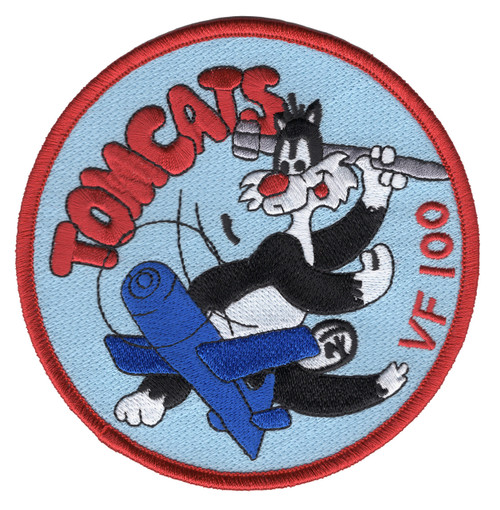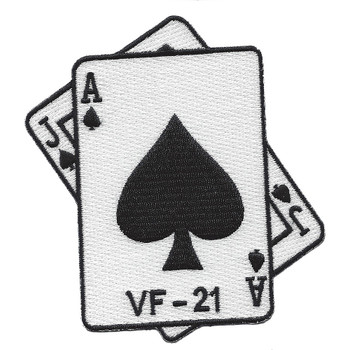Description
VF-100 Aviation Fighter Squadron WWII Patch (U.S. Navy) 4.5" x 4.5" Embroidered Patch with Iron-On Backing
Superior Materials: Made with premium polyester thread and durable twill fabric, ensuring long-lasting color and strength.
Advanced Embroidery Technology: Crafted using the most advanced embroidery machinery, guaranteeing intricate detail, sharp lines, and consistent quality every time.
Easy Iron-On Application: Features a heat-activated adhesive backing for quick, no-sew attachment. Simply position, iron, and press for a secure bond.
Versatile Use: Perfect for personalizing jackets, backpacks, uniforms, or any fabric surface that needs a touch of personality.
Durable and Washable: Designed to withstand everyday wear and occasional washing without fading or fraying.
Formations & Origins
Fighter Squadron 100 (VF-100), known unofficially as the "Tomcats," was originally established during World War II as part of the United States Navy’s drive to expand and reinforce its carrier-based aviation arm. While later iterations of VF-100 existed in the Cold War era as a fleet replacement squadron, the wartime version of VF-100 was created to fill the urgent need for naval fighter superiority in the Pacific Theater. As the war raged across the Pacific islands, the U.S. Navy was rapidly commissioning new squadrons and aircraft carriers, and VF-100 was among those formed to meet this surge demand. Designed to operate from fleet carriers, the squadron was equipped to intercept enemy aircraft, protect fleet movements, and provide critical support for amphibious landings.
Notable Commanders
Specific commanding officers of VF-100 during its WWII iteration are not well-documented in public military records. Like many squadrons formed quickly during the war, leadership often changed rapidly based on operational needs. However, it is clear that the commanders of VF-100 were selected from a cadre of experienced naval aviators—many likely veterans of earlier Pacific engagements—tasked with the dual responsibility of combat leadership and training new aviators under combat conditions. The leadership style in such squadrons leaned toward aggressiveness in the air and precision on the flight deck.
Major Campaigns/Operations
VF-100 saw action in several Pacific campaigns, though it did not achieve the high-profile fame of some other squadrons like VF-17 or VF-84. Nevertheless, its presence aboard fast carriers placed it squarely in the thick of Pacific combat. The squadron participated in escort missions, combat air patrols (CAP), and fleet defense during operations supporting the island-hopping campaign—particularly around the Marianas, the Philippines, and possibly the approach to Okinawa. These missions often involved daily dogfights with Japanese Zeroes, covering torpedo bombers and dive bombers during strikes on enemy installations, and enduring the constant threat of kamikaze attacks in the latter stages of the war.
Specialized Role/Equipment
VF-100 was initially equipped with the Grumman F4F Wildcat, later transitioning to the superior F6F Hellcat as the war progressed. The Hellcat was a beast—a carrier-based fighter that combined speed, firepower, and survivability. It was tailor-made for the vast aerial combat arenas of the Pacific. VF-100’s mission set was typical of carrier fighter squadrons: achieve and maintain air superiority, provide close air support for Marines hitting the beach, and screen U.S. carrier groups from incoming enemy aircraft. What made units like VF-100 indispensable was their ability to launch at a moment’s notice from heaving flight decks, even in the chaos of battle.
Acts of Heroism
While there are no publicly recorded Medal of Honor recipients directly from VF-100, heroism in such squadrons was a daily matter. Flying into enemy territory with minimal radar, dodging anti-aircraft fire, and engaging in deadly dogfights above hostile islands was standard procedure. In one lesser-known but poignant instance, a flight of VF-100 Hellcats scrambled to intercept incoming Japanese aircraft approaching a carrier task force. Outnumbered, they engaged aggressively, downing multiple enemy planes and forcing the remainder to turn back. One VF-100 pilot, badly shot up and bleeding, managed to nurse his aircraft back to the carrier, crash-landing on deck and saving both himself and his valuable plane. His quick thinking and refusal to abandon his aircraft in the sea preserved vital intelligence on enemy tactics found within the plane's gun camera footage.
Legacy & Notable Achievements
VF-100 may not have received the same renown as other squadrons like VF-17 or VF-84, but its legacy lives on in the traditions of naval aviation. It exemplified the kind of "workhorse" squadron that made victory in the Pacific possible—not flashy, but ferocious, professional, and relentlessly mission-focused. Its squadron patch, featuring a fierce, stylized cat, became an emblem of pride for its pilots and ground crews. After WWII, the designation VF-100 was re-used during the Cold War for a fleet replacement squadron responsible for training pilots on jet aircraft, notably the F-4 Phantom II. Though the missions changed, the legacy of competence and readiness carried forward. Today, aviation collectors and military history enthusiasts still seek out the original VF-100 patches and records, ensuring that the squadron’s service is not forgotten.
VF-100 stood as a quiet but lethal presence in the skies of the Pacific. It wasn’t about headlines—it was about keeping the carriers afloat, getting the job done, and bringing everyone home, one dogfight at a time.







